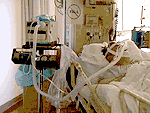Continuous Positive Airway Pressure (CPAP)
What is Continuous Positive Airway Pressure (CPAP)?
The purpose of CPAP is to provide oxygen and pressure, thereby making it easier for the patient to breathe. CPAP applies continuous pressure to the lungs, while the patient is both breathing in (inhaling or inspiration) and breathing out (exhaling or expiration), in order to hold open the air sacs in the lungs. CPAP may be delivered by either a small device or machine connected to tubing and a facemask or by a mechanical ventilator. The facemask fits snuggly over the patient's mouth and/or nose and is secured with straps around the head. Patients that are not successfully managed with CPAP most likely require a breathing (endotracheal) tube and full use of the breathing machine (mechanical ventilator).
Does the use of CPAP hurt?
The use of CPAP usually does not hurt. Some patients feel uncomfortable wearing the CPAP face mask.
How long is CPAP used?
CPAP may be used for a short or long period of time, depending upon the patient's underlying condition.
Are there any potential complications associated with use of CPAP?
Complications of CPAP include mask discomfort, skin sores around the mask, and bloating from swallowing air.
Continuous Positive Airway Pressure (CPAP)
